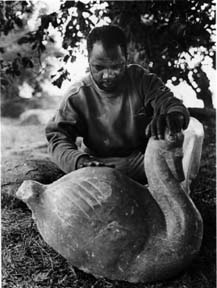![]()
![]()
[ The following essay has been adapted with the kind permssion of the Director, Chapungu Sculpture Park, from Chapungu: The Stone Sculptures of Zimbabwe (1995). All images © Chapungu Sculpture Park, Harare.]

Arthur Fata was born in 1963 in Harare and studied at the B.A.T. Workshop (at Harare's National Gallery) where he was able to use painting, print making and textiles as well as sculpture to express his ideas. Here he was introduced to the work of renowned artists such as Picasso and Matisse. "To me it was a great excitement to discover the work of these people - especially to see work that could come from 'within' a person, particularly in abstract art". This new and powerful imagery inspired Arthur rather than directly influencing what he was doing: he felt able to work differently but fired by the same concepts. After his time at the Workshop he was awarded a scholarship to study fine art in Bulgaria. He has also studied in England and Portugal. It was at an artists' workshop that in Portugal that he was first able to use machine tools on stone and he now believes that these should be available to all Zimbabwean stone sculptors. Interestingly, he does not feel that such methods pose any threat to their work so long as they see the process simply as a tool and resist getting to involved in the technique. In his opinion, there will always be a place for hand tools as there are many aspects of stone sculpture for which machinery is not suitable.
Arthur's sculpture is derived from powerful natural forms, such as rock formations and cliffs - but also from smaller subject matter such as birds and plants. His ideas evolve through a process of drawing, with imagery often becoming abstracted and sometimes combined with other images to create startling concepts - for example, Torso (1992, Serpentine and Wire) which shows a human figure partially wrapped in metal wire. This combines a traditional stone depiction of the human form with images seen of spiders wrapping their webs around the roots and stems of water plant. He uses drawing not just for his sculpture but also as an activity in its own right (landscapes, etc., which sometimes develop into painting). He will then take ideas from his painting to use in sculpture as well as working from photographic collages for subject matter. He explains that the most satisfying aspect of his work is the process of 4' building or subtracting mass. The space is used and the volume is controlled". Always looking for new ways of achieving this, his work often demands combinations of unusual materials and a highly imaginative method of using them to their best effect.
The stones favoured by Arthur Fata include the various Serpentines and Springstone, When working in this country; in Bulgaria he uses Marble and Granite which is harder than Zimbabwean stone, but is rarely available in large pieces. He says of his work, "I try to put more ideas into each piece - so each sculpture is new. But you have a collection of images to call on as memories of your experiences." For the future? "I wish I could carve a huge sculpture, but this would take a mountainl It would be a massive sculpture in which people could live".
Now thought of as one of the most innovative of the new generation of sculptors, his work has been seen in several important international exhibitions as well as in Zimbabwe. His major 1995 work "Wild Seedpod" has been much admired and considered one of the most significant of recent years.
Mawdsley, Joceline. Chapungu: The Stone Sculptures of Zimbabwe. Harare: Chapungu, 1997.